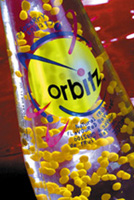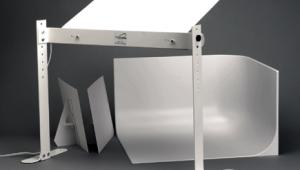Light Plays
Pumped Up Color
Well, we're halfway through the year 2001 and I'm finally getting used to the idea of living at the start of a new century. When we're all tucked away in the old photographers home we'll look back on this period as a time of major turmoil and exciting new opportunities in the photo world. There's new technology, new ways to view images, and new ways to take images. What has remained pretty constant is the desire of buyers of photography--magazines, ad agencies, graphic design firms, etc.--to look for the latest and freshest images. My work is subject to the same scrutiny as any other artist. If I were to stick with the style and look that made me so successful in the 1980s I surely would have a hard time finding any work. Even if I had kept my style static from the '90s I would find more and more clients looking for something newer and fresher. Don't get me wrong. Slavishly following trends and creating a raft of "me-too" images will get your portfolio bounced just as fast as a bunch of amateur snapshots. Like any artist I'm affected by the culture around me. I react to the slow but steady style shift that affects all artistic endeavors. My work has evolved over the years, even though it was hard to notice as it happened. Recently I assembled a new portfolio for my rep to show to prospective clients. The difference in styles became readily apparent. As I pulled out 10-year-old ads and replaced them with work from 2000 and 2001 I noticed a strong trend that has crept into my work--color. I don't mean bright color, I mean a strong, saturated fluid sense of color that most working pros today have to be able to create if they want to work. |
|||
Strong Color Play Without even realizing it I find that my work has picked up more and more of that look. I've always been a fan of mixing light sources, often combining flash exposure, HMI lighting, and tungsten in one shot. I shoot almost all of my work with a view camera so I've always used swings and tilts to bring my images into focus at times and at other times throw parts of my images out of focus. Let's explore the elements of an image that incorporate color in a fresh and interesting way. Get The Light Right |
|||
My technique is fairly simple. I figure out how much of the subject I want to keep neutral in color balance and sharp. Those areas get light from the strobe heads. The background and other parts of the set, whether it's a large set or a tiny tabletop, get a mixture of HMI and tungsten. Sometimes I gel the tungsten back to daylight balance, then apply the color gels I want. This gives me a totally daylight-balanced set, which makes it easier to figure out how the finished image will look. Where does the hot color come in? I almost always gel the background light sources with Rosco gels. By shooting with the strobe head modeling lamps off and the tungsten and HMI light sources on, I can freeze the strobe-lit areas and keep a 1/2 or 1 sec exposure to "burn in" the background color. If I'm hand holding I'll get a bit of motion blur around the outline of the subject, which can look pretty nice. Sometimes I'll swing a light source over the set during the exposure to create a long, blurred shadow. There are lots of ways to accomplish this effect, so it pays to shoot a lot and experiment. Besides the blur and the color I sometimes like a bit of selective focus. On a view camera it's easy--I just tilt the rear standard the "wrong" way to throw the top and bottom of the image out of focus. Once the back is swung I can simply focus on any one point in the image, knowing that most of the rest of the image is going to be soft. You can get a similar effect by using long lenses and very large apertures, but the effect isn't quite as convincing. As with anything in photography, trying to pump up color is a hit or miss affair. I tend to shoot a lot of film or fill up a lot of flash cards of digital "film" when trying something new. There are any number of ways to create strong color, from jacking the saturation in Photoshop to cross-processing negative film in E-6 chemistry. It pays to have as many bullets in your clip as possible, cause you never know when you're going to need them.
|
|||
|




















































